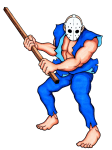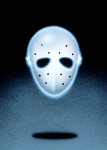Powet Alphabet: S is for Splatterhouse
by Sindra, filed in Games, Powet Alphabet on Nov.06, 2010
 Since the alphabet is the building block of our language, the Powet Alphabet is the building block of what makes us geeks.
Since the alphabet is the building block of our language, the Powet Alphabet is the building block of what makes us geeks.
Only missing Halloween by a week, but in honest, for some of us Halloween doesn’t end with a date. There a very special subgenre on geek that specializes in the supernatural, the arcane, and the frightening and everything in between. The horror geek, or “Shriek Geek” as I am dubbing them (and myself, in essence) leans toward media and realms that deal with the freakish, the ghoulish, and the downright creepy and chilling.
And you can tell there’s a fair amount of Shriek Geeks out there, since zombie movies are so prolific these days, along with supernatural thriller and survival horror games such as Resident Evil, Clock Tower, Silent Hill and so on. Then there’s a certain side of the Shriek Geeks that go for horror with a bit more of a gross and physically terrifying side to it, such as Clive Barker’s Jericho and Dead Space. But before those games came about, one gaming series in particular stood out for its freakish themes and chilling visuals and violence: Splatterhouse.
Splatterhouse is what happens when you throw Friday the 13th, Ghostbusters, and Poltergeist in a blender with a bit of Evil Dead sprinkled in for taste, then threw the concoction in an arcade cabinet. Splatterhouse was developed and released in 1988 for arcades and then later ported to the TurboGrafx-16 a little over a year later. The Wii’s Virtual Console also got it nearly two decades later. The game will also be bundled in with the 2010 release for the Playstation 3.
 The story is pretty simple and straight-up as far as horror media goes for the late ‘80s – Rick Taylor and Jennifer are two parapsychology students working on a thesis, when they are caught in a horrible thunderstorm. Seeking shelter from the storm, the two unknowingly stumble into the West Mansion, nicknamed the “Splatterhouse”, which was the residence of the late parapsychologist Dr. West who had gone missing after rumors of conducting unnatural experiments and was presumed dead. Suddenly, there’s a flash of lightning, Jennifer screams and Rick is knocked out by an unseen force. When he awakes, he is in the hellish basement of the mansion, Jennifer is missing, and a mysterious mask has affixed itself to Rick’s face. The “Terror Mask” grants Rick superhuman strength and subconsciously goads him into finding Jennifer and killing the undead and demonic creatures that now roam the West Mansion.
The story is pretty simple and straight-up as far as horror media goes for the late ‘80s – Rick Taylor and Jennifer are two parapsychology students working on a thesis, when they are caught in a horrible thunderstorm. Seeking shelter from the storm, the two unknowingly stumble into the West Mansion, nicknamed the “Splatterhouse”, which was the residence of the late parapsychologist Dr. West who had gone missing after rumors of conducting unnatural experiments and was presumed dead. Suddenly, there’s a flash of lightning, Jennifer screams and Rick is knocked out by an unseen force. When he awakes, he is in the hellish basement of the mansion, Jennifer is missing, and a mysterious mask has affixed itself to Rick’s face. The “Terror Mask” grants Rick superhuman strength and subconsciously goads him into finding Jennifer and killing the undead and demonic creatures that now roam the West Mansion.
Splatterhouse is a classic side-scrolling beat’em up with seven levels that take you both in and out of the mansion grounds. You’re given 4 (literal) hearts to start that represent your life bar, which can be partially replenished after finishing a level, but never added upon. You’re given basic punching and kicking attacks, and can grab weapons along the way that increase damage to enemies or for long-range, though some are one-use-only and other disappear if dropped or at the end of a level. Each level has an end boss to fight, which increase in difficulty as your game progresses. They get grosser too.
 That’s the thing about this game that made it so infamous – the sheer amount of violence and horrific imagery had been ramped up, seemingly just to see how much the developers could make it like its horror-movie counterparts. Splatterhouse pushed the envelope at the time for gore in a video game; hanging corpses that puke on you, strange muck creatures inhabiting the sewers, and severed hands that chase you are just a few of the things you’ll see. Satanic imagery was also showcased by a boss that is nothing more than an inverted cross with severed heads floating around it. Due to the sheer amount of violence in pixel-form, Splatterhouse was one of the first games to sport any kind of parental advisory on its box, and is largely credited for being a reason the ESRB was created. The TurboGrafx version of the game was released in the U.S. heavily edited, with much of the more gruesome animation toned down or cut out altogether, and the Inverted Cross boss removed and replaced. The Virtual Console version reflects this as well.
That’s the thing about this game that made it so infamous – the sheer amount of violence and horrific imagery had been ramped up, seemingly just to see how much the developers could make it like its horror-movie counterparts. Splatterhouse pushed the envelope at the time for gore in a video game; hanging corpses that puke on you, strange muck creatures inhabiting the sewers, and severed hands that chase you are just a few of the things you’ll see. Satanic imagery was also showcased by a boss that is nothing more than an inverted cross with severed heads floating around it. Due to the sheer amount of violence in pixel-form, Splatterhouse was one of the first games to sport any kind of parental advisory on its box, and is largely credited for being a reason the ESRB was created. The TurboGrafx version of the game was released in the U.S. heavily edited, with much of the more gruesome animation toned down or cut out altogether, and the Inverted Cross boss removed and replaced. The Virtual Console version reflects this as well.
 Regardless of the concern from parents, the game did well enough to pave the way for two sequels, as well as setting the groundwork for horror-themed games from then on out. In 2009, an announced reboot of the game was made public by Namco to be released in November 2010 and featuring a heavily updated re-imagining of the game’s story and mechanics. Will it live up to its origins? Only time will tell.
Regardless of the concern from parents, the game did well enough to pave the way for two sequels, as well as setting the groundwork for horror-themed games from then on out. In 2009, an announced reboot of the game was made public by Namco to be released in November 2010 and featuring a heavily updated re-imagining of the game’s story and mechanics. Will it live up to its origins? Only time will tell.
But so far, so good.


 PS3
PS3
 Famicom Dojo
Famicom Dojo KEEP PLAYING
KEEP PLAYING KEEP PLAYING: Rewind
KEEP PLAYING: Rewind Powet Toys
Powet Toys Powetcast
Powetcast Hitchhiker's Guide POWETcast
Hitchhiker's Guide POWETcast














